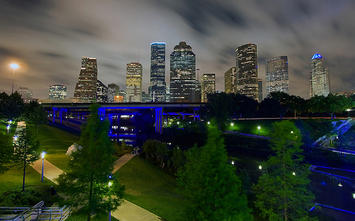
Do cities have a future? Pessimists point to industrial-era holdovers like Detroit and Cleveland. Urban boosters point to dense, expensive cities like New York, Boston and San Francisco. Yet if you want to see successful 21st-century urbanism, hop on down to Houston and the Lone Star State.
You won't be alone: Last year Houston added 141,000 residents, more than any region in the U.S. save the city's similarly sprawling rival, Dallas-Fort Worth. Over the past decade Houston's population has grown by 24%--five times the rate of San Francisco, Boston and New York. In that time it has attracted 244,000 new residents from other parts of the U.S., while older cities experienced high rates of out-migration. It is even catching up on foreign immigration, enjoying a rate comparable with New York's and roughly 50% higher than that of Boston or Chicago.
So what does Houston have that these other cities lack? Opportunity. Between 2000 and 2009 Houston's employment grew by 260,000. Greater New York City--with nearly three times the population of Houston--has added only 96,000 jobs. The Chicago area has lost 258,000 jobs, San Francisco 217,000, Los Angeles 168,000 and Boston 100,004.
Politicians in big cities talk about jobs, but by keeping taxes, fees and regulatory barriers high they discourage the creation of jobs, at least in the private sector. A business in San Francisco or Los Angeles never knows what bizarre new cost will be imposed by city hall. In New York or Boston you can thrive as a nonprofit executive, high-end consultant or financier, but if you are the owner of a business that wants to grow you're out of luck.
Houston, however, has kept the cost of government low while investing in ports, airports, roads, transit and schools. A person or business moving there gets an immediate raise through lower taxes and cheaper real estate. Houston just works better at nurturing jobs.
It's not just smug coastal places getting smoked by Texas. Since the collapse of the housing bubble Houston has outperformed Sunbelt counterparts like Phoenix, Las Vegas and Los Angeles. A big factor has been that manufacturing, professional services, international trade and technology industries have been the primary drivers of the city's economic growth--rather than construction and speculation. Ironically, this has increased home values. Since 2007 prices of homes in Houston have ticked slightly higher, while those in Las Vegas, Phoenix, Los Angeles and the Bay Area each are down by more than 35%.
Some traditional urbanists will concede these facts but then try to shift the focus to "qualitative" factors: the best-educated residents, the highest salaries, the most expensive real estate. Although it also attracts a large number of low-skill migrants, Houston has considerably expanded its white-collar workforce. According to the Praxis Strategy Group, Houston's ranks of college-educated residents grew 13% between 2005 and 2008. That's about on par with "creative class" capital Portland, Ore. and well more than twice the rate for New York, San Francisco or Los Angeles.
But Houston's biggest advantage cannot be reduced to numbers. Ultimately it is ambition, not style, that sets Houston apart. Texas urbanites are busy constructing new suburban town centers, reviving inner-city neighborhoods and expanding museums, recreational areas and other amenities. In contrast with recession-battered places like Phoenix, Houston remains remarkably open to migrants from the rest of America and abroad.
Houston, perhaps more than any city in the advanced industrial world, epitomizes the René Descartes ideal--applied to the 17th-century entrepreneurial hotbed of Amsterdam--of a great city offering "an inventory of the possible" to longtime residents and newcomers alike. This, more than anything, promises to give Houstonians the future.
This article originally appeared in Forbes.com.
Joel Kotkin is executive editor of NewGeography.com and is a distinguished presidential fellow in urban futures at Chapman University. He is author of The City: A Global History. His newest book is The Next Hundred Million: America in 2050
, released in Febuary, 2010.













Missing it
Houston has the ability to annex its growth something which many municipalities cannot do. Houston is 579 square miles large, and it can continue to grow. Not many other American cities can do that.
The backbone of Houston's economy is still energy followed by a medical sector that receives substantial public investment.
"Houston, however, has kept the cost of government low while investing in ports, airports, roads, transit and schools."
Houston made its investments in its ports a long time ago, not something new. Regarding schools, Houston and Texas overall, is facing a day of financial reckoning. School tax rates are among the highest.
How long will this prosperity in Houston, and Texas for that matter, last when we have this coming right at us: http://www.chron.com/disp/story.mpl/metropolitan/7008236.html